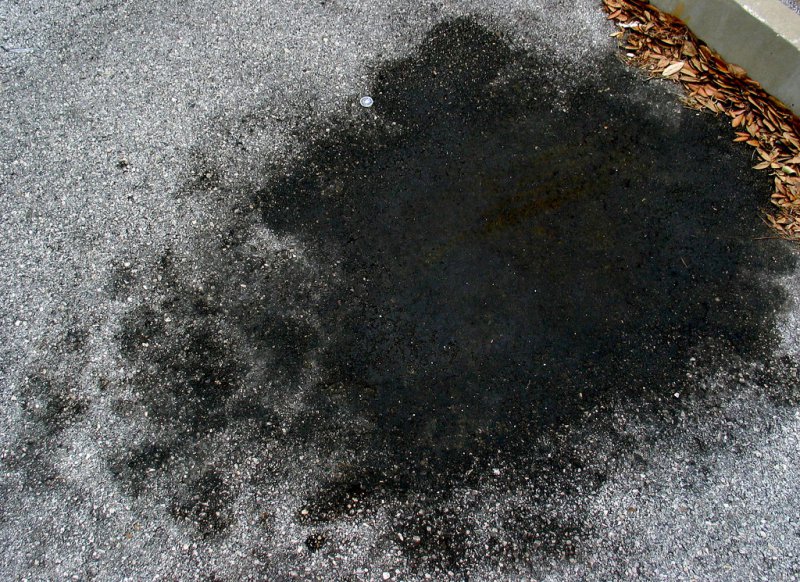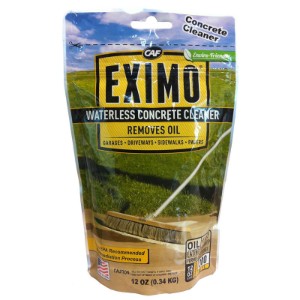Mon, Dec 3, 2018
Article may contain affiliate links. As an Amazon Associate I earn from qualifying purchases.
Do you want to remove oil stains from your concrete or asphalt driveway?
Are you tired of your Homeowners Association (HOA) telling you to clean up those unsightly stains?
 Photo: cdsessums / CC
Photo: cdsessums / CC
If you’ve searched for ways to remove oil stains online, you’ve probably found a number of crazy ideas such as using:
Dish Soap
Powdered Laundry Detergent
Baking Soda
WD-40
Cola
Kitty Litter
Pressure Washing
Unfortunately, none of these methods will effectively get rid of oil stains.
That’s because none of those products were specifically designed to remove oil from concrete or asphalt.
What you should do instead is use a product that is designed to naturally break down the oil, without all of the elbow grease or wasted water.
Related: What’s the difference between 5w30 and 10w30?
Step 1: Use a Natural Waterless Cleaner
We prefer to use a natural waterless concrete cleaner because it is easy to use and better for the environment.
Our favorite brand of concrete cleaner is called EXIMO and can be found on Amazon (check price).
It is available in a small 12 oz package that will give you enough cleaner to remove an average sized oil spot from under one vehicle. Or, you can find it in a 3 lb tub that will take care of large or continuous oil spots.
EXIMO is safe for pets and the environment, unlike laundry detergent, dish soap or WD-40.
It has been shown that laundry detergent is responsible for 50% to 75% of the phosphorus in lakes and rivers - leading to vegetation overgrowth and fish mortality.
Let’s be honest, pouring laundry detergent on your driveway and washing it down the sidewalk is not the most environmentally friendly thing to do.
EXIMO uses a natural process called bioremediation to breakdown the oil. The microorganisms in the powder eat hydrocarbons in the oil and convert them into water and carbon dioxide.
Rather than washing the oil down the storm drain with harmful detergents and cleaners, EXIMO is designed to breakdown the oil naturally.
Step 2: Spread a Thin Coating Over Oil Spot
We have found that it is best to use the product on a dry area. Before you pour the cleaner onto a new oil spot, attempt to wipe it up with a paper towel first.
Next, apply about a 1⁄4 cup or less of EXIMO to the oil stain. Use a broom to carefully spread the product over the entire stained area.
There should be no excess or loose powder remaining on the spot. That means if you stomp your foot on the oil spot, there should be no dust cloud. If there is, you should keep spreading the product over and beyond the oiled area until the powder is completely dispersed.
Step 3: Apply Once Per Week Until Gone
After you spread EXIMO over the oil stain it will begin working right away. However, you should reapply it again one week later for the best results.
Following the first application, the microorganisms in the product will eat the oil directly on the surface. The next applications will help get rid of deep oil stains that have penetrated into the pores of the concrete or asphalt - something household cleaners just can’t do.
In our tests we found that it took two applications to start seeing results.
If you are trying to clean an old or large oil spot from your driveway it can take several applications for it to be removed using EXIMO.
Trust us, the results are worth the wait.
Conclusion
While it can be tempting to use household cleaners like laundry detergent or dish soap to clean oil stains on your driveway, it may actually do more harm than good.
In fact, laundry detergents are responsible for 50% to 75% of the phosphorus in lakes and rivers. Excess phosphorus leads to vegetation overgrowth and lower survival rates for fish.
Plus, you will be washing the oil down the storm drain along with the detergent. Just one quart of oil can contaminate 250,000 gallons of drinking water!
Instead of using a DIY home remedy, we recommend using a natural waterless concrete cleaner that is more effective and better for the environment. Our favorite brand of cleaner is called EXIMO and can be found on Amazon (check price).
What methods have you used to remove oil stains from concrete and asphalt driveways?
READ NEXT

